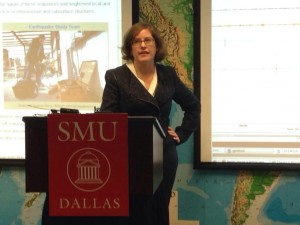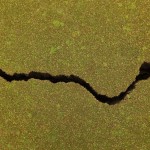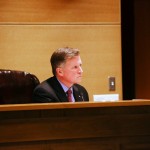Meet the Quake Detective Studying the North Texas Tremors
From KERA News:

Doualy Xaykaothao KERA News
Heather DeShon leads an SMU research team looking into what’s causing the earthquakes in and around Azle and Reno, which are northwest of Fort Worth.
Heather DeShon is a geophysicist at SMU. She’s studied earthquake sequences in Indonesia, Nicaragua, but also in North Texas — in Cleburne. Now she leads a team collecting data in towns northwest of Fort Worth.
After a cluster of small earthquakes hit in November, DeShon and SMU scientistsplaced seismic stations in Parker, Wise and Tarrant counties.
“The seismic stations measure the acceleration of the ground,” DeShon said. “When an earthquake happens, it moves the ground. What this allows us to do is to record the seismic waves, and that allows us to do a better job to locate the earthquakes.”
The U.S. Geological Survey sent DeShon’s team small blue boxes called NetQuake stations.
“We put them in secure locations with wireless access,” DeShon said. “And every hour, the station pings the USGS, and sends the last hours worth of data. You can view that online, in near real time, and the data will eventually be archived for anyone to look at.”
These instruments are recording accelerations or movements underground, 24/7.
“Once we know where the earthquakes are occurring, we can figure out the mechanism of the earthquake,” DeShon said. “If they’re associated with a fault, how large is that fault? How big an earthquake might we expect in the future?”
The information being collected could help determine seismic hazards.
“For the Dallas-Fort Worth area in particular, if it appears that something is changing, and I’m not saying it is, but if that ends up being the conclusions, then we need to pass that data and those conclusions on to other public agencies,” DeShon said.
The results of this SMU research could give emergency managers, building engineers and local officials a better picture of the risks. The goal is to save lives, she says.
“I like working on something that I feel like potentially makes a difference, potentially helps people,” she said. “Because if we do, the day to day activities of locating the earthquakes might sound dry, but the consequences of that are not.”
This the second of several stories in a series called “What’s Behind the North Texas Quakes?”
Earthquake public forum to be held June 18 in Azle
What’s behind the earthquakes in North Texas? KERA and StateImpact Texas will host a free public event to explore the issues at 7 p.m. June 18 at the Azle High School Auditorium. Learn more about the forum here.

